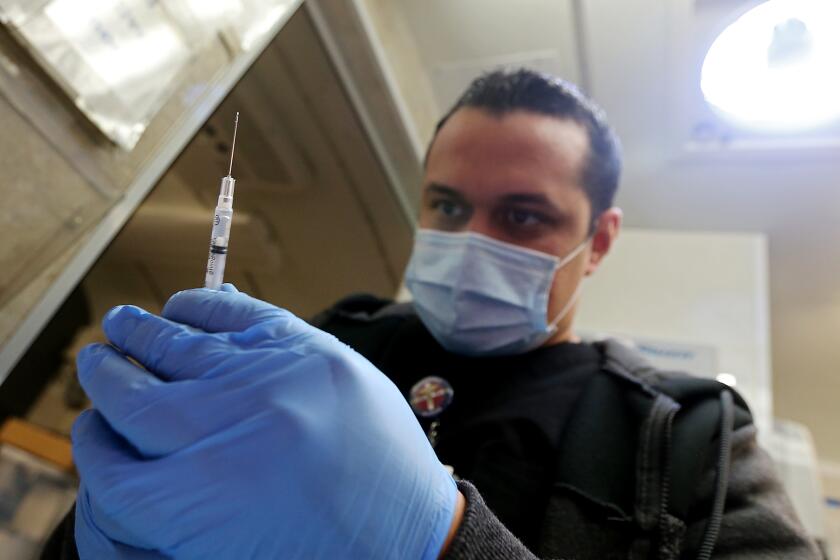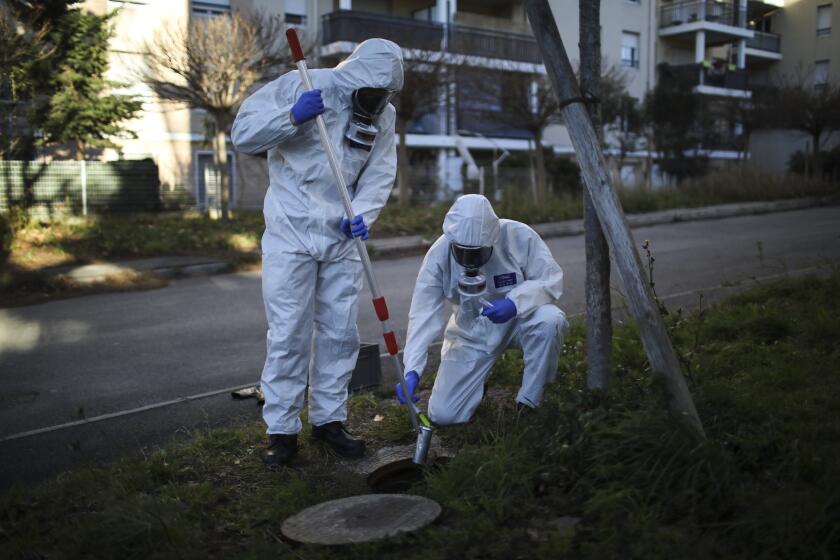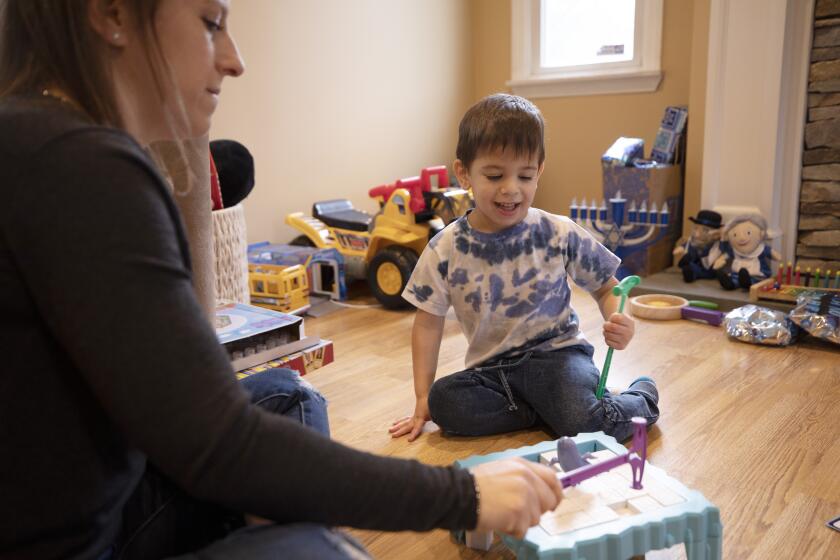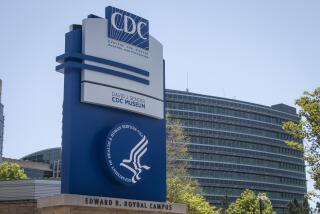Omicron subvariant BA.2 spreading rapidly in L.A. and across the nation

The U.S. may approve a fourth dose of COVID-19 vaccine as early as this week for citizens over age 50.
- Share via
The percentage of Omicron subvariant BA.2 cases is rising in Los Angeles County, a trend seen elsewhere nationwide as officials sound the alarm about Congress’ failure to provide critical funding for vaccinations, tests and anti-COVID drugs.
Officials in L.A. County and nationally have warned about the risk to public health if new pandemic federal funding fails to be approved. There is no money left to reimburse doctors for COVID care for uninsured Americans, and funds will soon run out to provide vaccinations, Xavier Becerra, the U.S. secretary of Health and Human Services, said this week.
According to data released Thursday, 14.7% of coronavirus samples analyzed for L.A. County between Feb. 27 and March 5 were the highly contagious BA.2 subvariant. That’s more than double the previous week’s figure of 6.4%.
L.A. County Public Health Director Barbara Ferrer continued to urge residents to adhere to the strong recommendation issued by her department and state health officials to continue masking in indoor public settings.
“Along with the increasing circulation of the more-infectious BA.2 subvariant, everyone, especially those who are at elevated risk or live with someone at elevated risk, should wear a high-quality mask and get vaccinated and boosted,” Ferrer said in a statement Thursday.
From Feb. 27 to March 5 — the most recent data available — 14.7% of coronavirus cases sequenced in L.A. County were found to be BA.2, up from 6.4% the prior week.
More recent national estimates have suggested BA.2 will quickly become dominant soon. BA.2 comprised an estimated 35% of analyzed samples between March 13 and March 19; the previous week, it made up 22%, according to the U.S. Centers for Disease Control and Prevention.
In the southwestern U.S. — which includes California, Arizona, Nevada and Hawaii — BA.2 made up an estimated 41% of coronavirus samples. The previous week, it was 28%. And for the first time, BA.2 is the now estimated to be the dominant subvariant in the Northeast, making up more than half the analyzed coronavirus cases in New York, New Jersey and New England.
BA.2 is believed to be 30% to 60% more contagious than the earlier Omicron subvariant. BA.2, however, doesn’t appear to result in more severe illness, and it’s likely that people recently infected with the earlier Omicron subvariant will have a decent degree of at least short-term immunity to BA.2.
It’s not clear whether the rise of BA.2 will result in a major surge that will strain hospitals yet again, or whether BA.2 will merely slow the continued decline in new coronavirus cases. But officials say it’s prudent to be prepared for the worst, wear masks in indoor public spaces and get up to date on vaccinations and booster shots.
Experts are watching for a potential new COVID-19 surge in the U.S. — and wondering how long it will take to detect.
One potential warning sign is from Britain, which has seen its coronavirus case rate more than triple since late February and is reporting nearly 1,200 cases a week for every 100,000 residents, according to Johns Hopkins University. Coronavirus-positive hospitalizations are also up by 17% in Britain over the last week, and deaths are on an upward trend as well, according to Britain’s coronavirus data tracking website.
But not all European nations are seeing a BA.2-fueled surge; Spain’s case rate is much lower than Britain’s and appears to be flat, at around 250 cases a week for every 100,000 residents.
California is averaging about 74 cases a week for every 100,000 residents, and the U.S. is averaging 62 cases a week for every 100,000 residents.
In the U.S., the Northeast is likely to provide some hints as to how BA.2 might influence pandemic trends in California.
“Over the past week, we have seen a small increase in reported COVID-19 cases in New York state and New York City, and some increases in people in the hospital with COVID-19 in New England, specifically, where the BA.2 variant has been reaching levels above 50%,” CDC Director Dr. Rochelle Walensky said Wednesday.
“This small increase in cases in the Northeast is something that we are closely watching as we look for any indication of an increase in severe disease from COVID-19 and track whether it represents any strain on our hospitals. We have not yet seen this so far,” Walensky said.
The City Council voted 13-1 to make it voluntary for businesses to verify that patrons are vaccinated. But because the vote was not unanimous, the proposed ordinance will undergo a second, procedural vote next week.
Cases are relatively flat nationwide and in California. In L.A. County, coronavirus cases are still declining or flat, when accounting for a backlog of cases recently reported that actually occurred earlier in the pandemic.
Officials in L.A. County and at the White House have voiced deep worry about Congress’ failure to provide additional federal funding to respond to the pandemic.
Last week, Ferrer said that because of the stalemate in Washington, many of L.A. County’s community groups were no longer expected to be reimbursed for the vaccination or testing of uninsured people as of this week, a situation that “wrecks our network immediately.”
“We need to be prepared for a potential challenge in the future — and in the near future. We don’t want to be caught off guard,” Ferrer said.
Moderna says it will ask regulators to authorize its COVID-19 vaccine for children under 6 but several hurdles need to be cleared.
Last week, Dr. Sara Cody, the public health director for Santa Clara County, Northern California’s most populous county, said: “COVID funding has essentially collapsed. That is breathtaking and shocking in the middle of a global pandemic.”
Becerra said at a news briefing Wednesday that there’s no money left in the fund Congress created to reimburse doctors for COVID care to Americans, particularly the uninsured. The fund will also need to stop accepting new claims for vaccination services around April 5 — less than two weeks away.
“Examples of entities this will impact include, but are not limited to, ambulances, testing providers, pharmacies, clinics and hospitals,” officials from the L.A. County Department of Public Health said in response to an inquiry from The Times. “The county’s options to address this lack of funding are limited as it is a federal program.”
Maintaining the capacity to administer hundreds of thousands of vaccine doses and coronavirus tests per day, as well as ready access to therapeutics, is also a major component of the COVID-19 preparedness blueprint California unveiled last month.
“As we move into the third year dealing with COVID, we know a lot more. We know how to use the tools in the toolkit. We’re hoping not to use them all all the time, but we know how to use them in more precise ways, what metrics matter,” Dr. Mark Ghaly, California’s health and human services secretary, said during an appearance this week on the Johns Hopkins Bloomberg School of Public Health’s “Public Health On Call” podcast.
But it remains to be seen how, or whether, the lack of new federal funding might affect the state’s goals. The California Department of Public Health “is aware of changes to COVID-19-related federal reimbursement and is assessing the impact on state programs and constituencies,” officials said in a statement Friday.
“Our priority throughout the pandemic has been to provide all Californians, irrespective of insurance status or ability to pay, access to testing and vaccines,” the statement continued. “We continue to be focused on this priority and will ensure that we provide these important services based on the needs of individuals and communities, and not based on the bureaucratic structures of government or the specific funding sources.”
Los Angeles lost more residents than any other county in the nation during the first year of the COVID-19 pandemic, new census data show.
Already, the U.S. government has had to cancel a purchase of some potentially life-saving anti-COVID drugs that had been planned for this week. The federal supply of a type of anti-COVID drug known as monoclonal antibodies will likely run out in May if funding is not replenished, Becerra said. The monoclonal antibodies that can be used against the Omicron variant are sotrovimab and bebtelovimab.
In addition, the federal government now must scale back plans to buy more doses of Evusheld, a drug intended to prevent COVID-19 among people who haven’t been exposed to the coronavirus, and either have a weakened immune system because of a medical condition or cannot get vaccinated for medical reasons. “This increases the risk of having an insufficient supply of this treatment by the fall,” Becerra said.
The U.S. government has enough vaccines to give immunocompromised people a fourth dose this spring, and, if eventually authorized, fourth doses to seniors and other vulnerable people. But if a fourth dose — also known as a second booster shot — is made available for the general public, the current funding situation will result in the U.S. not having an adequate supply for all Americans, said Jeff Zients, the White House COVID-19 task force coordinator.
“Not having enough vaccines is completely unacceptable, as vaccines have proven to be our single most important tool in protecting Americans. We should be securing additional supply right now,” Zients said at a news briefing Wednesday. “Many other countries are already doing so. In fact, Japan, Vietnam, the Philippines, and Hong Kong have already secured future booster doses.”
Without additional funds, the U.S. also risks losing its domestic testing manufacturing capacity. “And because it takes months to ramp back up to rebuild capacity, failure to invest now will leave us with insufficient testing capacity and supply if we see another surge in cases and demand for testing increases once again. That should not be allowed to happen,” Zients said.
“These consequences will only get more significant over time, with less treatments, vaccines, and tests for the American people,” he added.
More to Read
Sign up for Essential California
The most important California stories and recommendations in your inbox every morning.
You may occasionally receive promotional content from the Los Angeles Times.




















